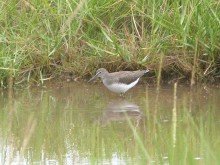One word sums up September for the keen nature watcher; SANDPIPER! We expect common sandpipers regularly in autumn as they make their way south and a small number of green sandpipers are always likely to be around. Most years a number of curlew sandpipers are likely and so it was this year but the length of time they stayed here was possibly unusual. Wood sandpipers are far from common but could not be classed as rare and a few were about in September to make the count four. However, I do not think anyone expected the other sandpipers that were going to suddenly appear. First a Baird’s sandpiper turned up on Brownsea and then moved off to the Fleet. Shortly afterwards a stilt sandpiper arrived at Lodmoor in Weymouth and at the same time a least sandpiper was there too! This was the first Dorset record for a stilt and the third for a least. That was not the end of it as a few days later a spotted sandpiper appeared at Abbotsbury Swannery and is still there after a couple of weeks. No sooner had news broken of its arrival people started flooding on to Portland to see a rare buff-breasted sandpiper! Incidentally, the stilt sandpiper moved to the Middlebere channel near Arne and is still there as the month closes.
Why should we have an influx of six exceedingly rare sandpipers all together? You do not have to look too far for an answer. All are north American birds that nest in the Arctic areas of Canada and then migrate south about now to central and southern America. Their migration coincided with the hurricane season and instead of flying south they were blown out into the Atlantic. Many birds will have perished but the six we have had here in Dorset were the ‘lucky’ ones, at least they made landfall. However, tired and lost, it is unlikely they will stay the winter here and return to their breeding grounds in spring. I find it hard to reconcile that the dreadful hurricanes that brought death and destruction to the Caribbean should bring delight to British bird watchers.
September always throws up oddities during migration and hoopoe and wryneck were both present this month along with yellow-browed warblers. A greenish warbler on Portland was less predictable and, indeed, the one that turned up in the mist nets at the Observatory was the first autumn record for the species in Dorset. A rose coloured starling and a common rosefinch completed the haul of interesting species in the month.
The month end record list contains a number of mammal records too. A polecat seen near Weymouth is very unusual as they are both rare and nocturnal. One of our contributors was lucky enough to able to go on a dormouse survey and see dormice close up. Red squirrels were busy storing nuts away on Brownsea seemingly oblivious to the visitors watching them. Out at sea a pod of bottle-nose dolphins were regularly seen and were of Portland Bill for a few days.
Autumn also sees a number of migrating moth species and Radford’s flame-shoulder and barred sallow were trapped this year. Two other species, the amazingly impressive clifden nonpareil and the feathered brindle were also remarkable finds. The ‘clifden’ actually was quite widespread and found in several traps and it is hoped it may be becoming established here as a brreeding species.
Overall September was a quite month in some ways and headline making in others! Whilst migration for birds is well under way it was not until the equinox passed that the numbers of birds passing through really ‘took off’ with thousands of swallows along with other species all heading south. Meanwhile there seems to be little evidence of our wintering species arriving in great numbers. That though will undoubtedly happen in October.
See all the details of the Nature of Dorset in September here: https://www.natureofdorset.co.uk/records-diary/september-2017
Peter Orchard







